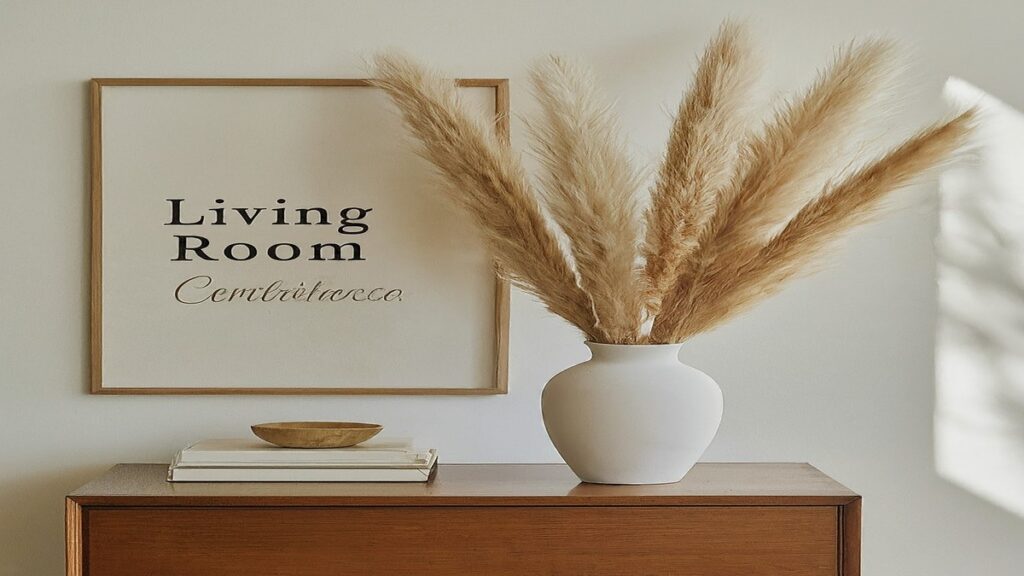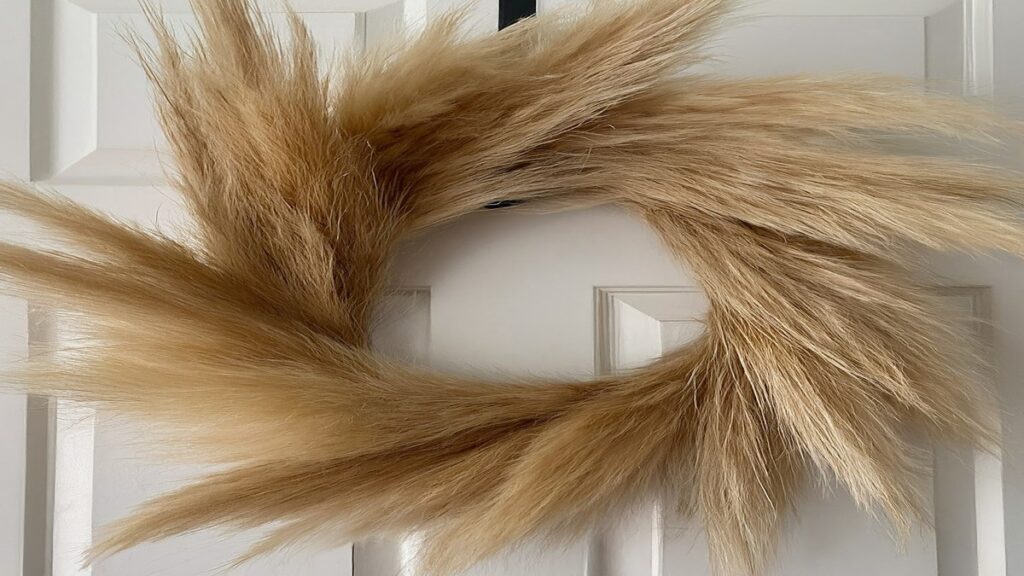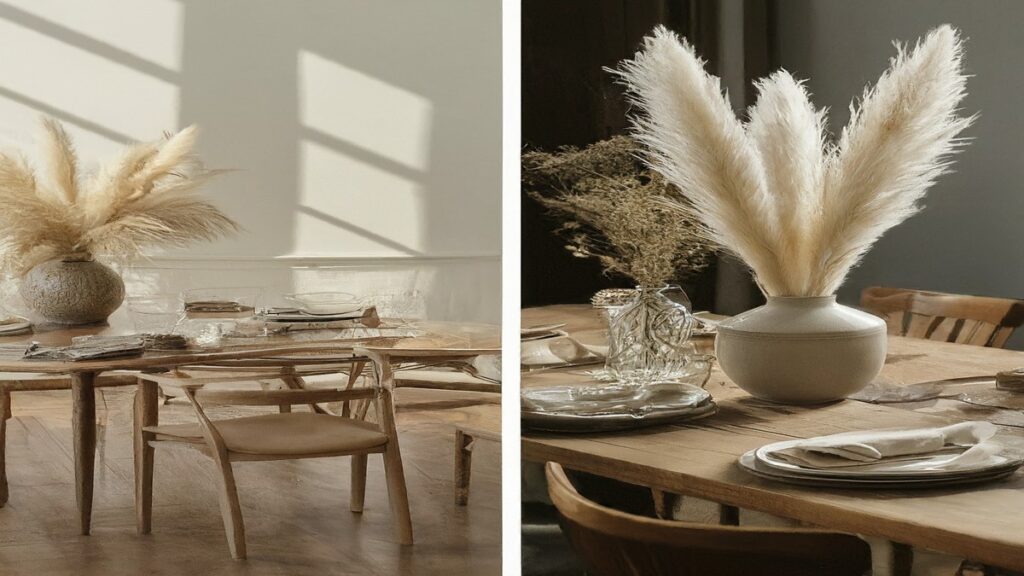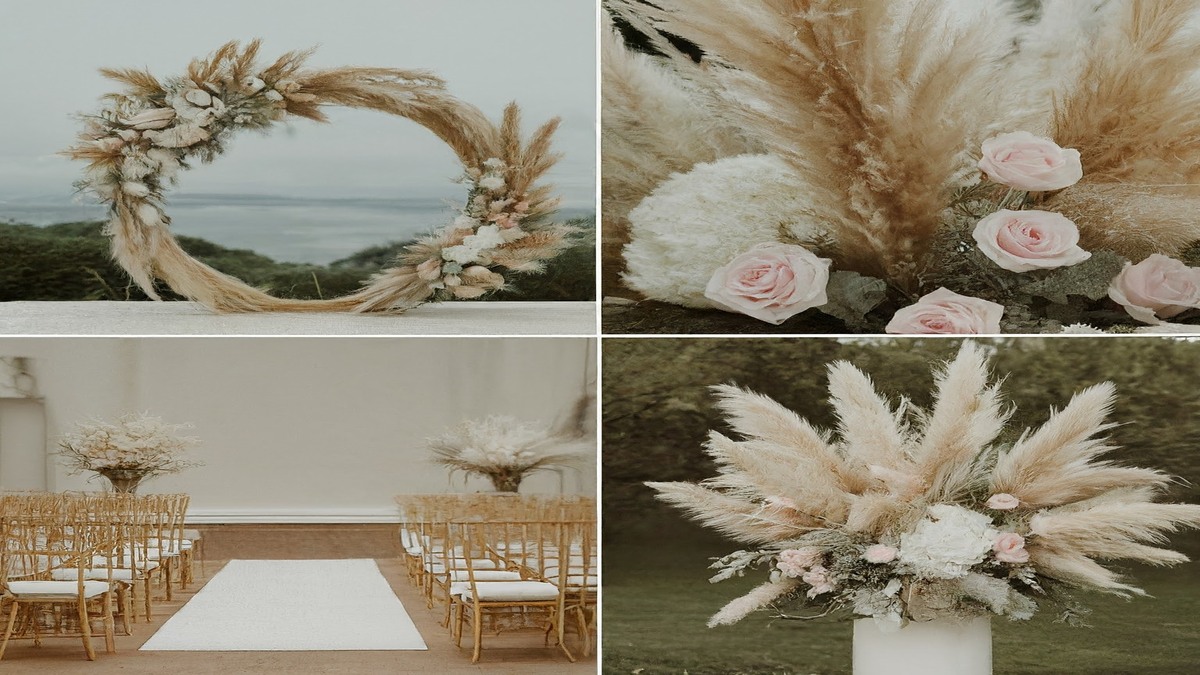What is pampas grass used for? In terms of aesthetic appeal, pampas grass is valued for its tall, feathery plumes that sway gracefully in the breeze, creating a dreamy and enchanting atmosphere. Its neutral colors and varied textures make it a popular choice for floral arrangements and home decor, particularly in weddings and other special events. Dried pampas grass, in particular, has seen a surge in popularity as it offers a sustainable and stylish option for long-term decoration.
Decorative Uses
Pampas grass is a versatile and stylish addition to home decor and events, offering a blend of rustic charm and modern elegance. Here’s how you can incorporate pampas grass into various settings:
Home Decor Ideas:

- Living Room: Create a focal point with a large vase filled with tall pampas grass plumes. For a more dynamic look, mix different colors of pampas grass or add other dried flowers.
- Bedroom Accents: Place smaller arrangements on nightstands or dressers for a soft, calming effect. You can also use pampas grass as a wall hanging to add texture.
- Bathroom Touches: A simple vase with a few stems of pampas grass can transform your bathroom into a spa-like retreat. It’s perfect for adding a natural element to the space.
Event Decorations:

- Wedding Trends: Pampas grass is popular for creating lush, romantic settings. Use it for aisle markers, centerpieces, or as part of the bridal bouquet.
- Party Setups: For a boho-chic vibe, incorporate pampas grass into your party decor. It works well for both indoor and outdoor settings, adding height and drama to the space.
Creative Ideas:
- Seasonal Displays: Adapt your pampas grass arrangements to the season by adding seasonal flowers or decorations.
- DIY Projects: Create your own pampas grass decorations, like wreaths or garlands, for a personalized touch.
Remember, pampas grass can shed, so it’s a good idea to spray it with hairspray to minimize mess. With these ideas, you can enjoy the beauty of pampas grass in many aspects of your life and special occasions.
DIY and Crafting Projects
DIY and crafting projects with pampas grass can add a unique and natural touch to your home decor or special events. Here are some ideas and tips for creating wreaths, centerpieces, and bouquets:
Creating Wreaths:

- Start with a grapevine or wire wreath as your base.
- Attach pampas grass stems to the wreath form using floral wire, ensuring they are securely fastened.
- For a fuller look, layer the pampas grass until you achieve the desired density.
- You can add other elements like dried flowers or ribbons for extra color and texture.
Centerpiece Ideas:

- For a simple yet elegant centerpiece, place a tall vase filled with pampas grass on your table.
- Combine pampas grass with other dried flowers or greenery to create a more elaborate arrangement.
- Consider using different heights and colors of pampas grass to add depth to your centerpiece.
- Metallic or ceramic vases can complement the natural tones of the pampas grass.
DIY Bouquets:

- Begin with a hydrangea base and add your central flowers low and deep into the bouquet.
- Integrate pampas grass stems, ensuring they are prominent and add height to the bouquet.
- Use a spiral technique with the stems to create a cohesive and full look.
- Bind the stems with floral tape and cover with a decorative ribbon for a finished appearance.
Remember to handle pampas grass carefully as it can shed. Spraying with hairspray can help minimize this and preserve your creations longer. With these ideas, you can enjoy crafting beautiful, natural decorations with pampas grass.
Gardening and Landscaping
Pampas grass is a stunning addition to gardens and landscapes, offering both beauty and functionality. Here’s a guide to help you with planting, growing, and using pampas grass:
Planting and Growing Tips:
- Location: Choose a sunny spot with at least six hours of sun per day and well-drained soil.
- Spacing: Space clumps about 8 feet apart to accommodate their full size at maturity.
- Soil: Pampas grass prefers moist, well-draining soil that is rich in nutrients. Compost can be a good soil amendment.
- Watering: Water new plants deeply. Established plants typically thrive on natural rainfall unless there’s an extreme drought.
- Temperature: It’s hardy in USDA zones 7 through 11 and can withstand both heat and high humidity.
Maintenance and Care:
- Pruning: Cut back the grass to the ground in late winter or early spring to encourage new growth.
- Fertilizer: A well-balanced fertilizer can be applied after pruning, although it’s not essential.
- Safety: Keep it away from structures and outdoor cooking areas as it is highly flammable.
Landscaping Uses:
- Garden Beds: Plant pampas grass in the center of a garden bed to create a fountain of greenery topped by fluffy plumes.
- Living Screens: Use it to create a living screen or a border backdrop by planting several in a row.
- Erosion Control: It’s often used to stabilize stream banks and coastal landscapes due to its robust root system.
Remember, while pampas grass is a low-maintenance plant, it can become invasive. It’s important to manage its growth and spread responsibly. Enjoy the beauty and practicality it brings to your garden!
Environmental and Safety Considerations
When considering the use of pampas grass, it’s important to weigh both its environmental benefits and safety considerations:
Ecological Benefits:
- Soil Stabilization: Pampas grass can help stabilize soil and prevent erosion, making it useful for ecological restoration and landscaping projects.
- Wildlife Habitat: It occasionally provides a habitat for wildlife, offering shelter and nesting sites for birds, and a safe haven for small mammals and insects.
Potential Invasiveness:
- Displacement of Native Species: Pampas grass can displace native plants, creating habitats with lower biodiversity. It’s considered invasive in some regions due to its ability to self-seed and spread quickly.
- Difficulty in Control: Once established, it can be challenging to control its spread, which can threaten native ecosystems.
Safety for Pets:
- Non-Toxic: Pampas grass is non-toxic to dogs, cats, and horses, so it doesn’t pose a risk of poisoning if ingested.
- Physical Harm: However, the sharp edges of the leaves can cause cuts and irritation. It’s advisable to plant it in areas where pets won’t come into contact with it to prevent accidental injuries.
In summary, while pampas grass has certain ecological benefits, its potential invasiveness requires careful consideration and management. Additionally, while it is safe for pets in terms of toxicity, precautions should be taken to prevent physical harm due to its sharp foliage.
Floral Arrangements
Florists often use pampas grass in floral arrangements for its tall, feathery plumes that add texture and a touch of whimsy. Here’s how they typically incorporate it:
How Florists Use Pampas Grass:
- Base for Arrangements: Pampas grass is often used as a base to create an outline or a backdrop for other flowers.
- Height and Texture: It adds height and texture to arrangements, making them more dynamic and interesting.
- Large-Scale Installations: For weddings and events, pampas grass can be used in large-scale installations, such as floral arches or centerpieces.
Popular Combinations with Other Flowers:
- With Hydrangeas and Dahlias: Pampas grass is commonly paired with pink hydrangeas and café au lait dahlias to create an ombre effect.
- With Roses and Orchids: Blousy roses and orchids are also great companions for pampas grass, offering a luxurious and elegant look.
- With Eucalyptus and Oats: A more rustic arrangement can be achieved by combining pampas grass with eucalyptus and grains like oats.
For weddings, pampas grass is not only trendy but also practical, as it can be preserved and used as home decor after the event. Florists may use treated varieties to ensure longevity, and these can be fluffed up and maintained with hair spray.
If you’re considering using pampas grass for your wedding or home decor, remember to handle it carefully as the edges can be sharp, and always check if it’s considered invasive in your area. With the right care and combination, pampas grass can truly elevate the aesthetic of any space or event.
Comparative Analysis
Pampas grass, known for its striking plumes and height, is a popular choice for ornamental use. Here’s a comparative analysis with other ornamental grasses, along with its pros and cons:
Pampas Grass vs Other Ornamental Grasses:
- Height: Pampas grass can reach over 8 feet in height, making it one of the tallest ornamental grasses.
- Growth Pattern: It tends to grow in dense clumps and can provide a privacy screen or be used as a focal point in a garden.
- Maintenance: Compared to some other grasses, pampas grass is relatively low-maintenance once established.
Pros of Pampas Grass:
- Aesthetic Appeal: Its tall, feathery plumes add elegance and drama to landscapes.
- Privacy: The dense growth can serve as a natural privacy barrier.
- Wildlife Habitat: It creates habitats for certain wildlife species.
- Drought Tolerance: Pampas grass is drought-tolerant and can thrive in various soil conditions.
Cons of Pampas Grass:
- Invasiveness: It can be invasive, with a single plant releasing up to 400,000 seeds, potentially crowding out native plants.
- Fire Hazard: The dry, brushy leaves can be a fire hazard in dry areas.
- Difficulty in Removal: Once established, it can be challenging to remove due to its extensive root system.
Comparison with Other Ornamental Grasses:
- Feather Reed Grass: Grows in a more upright habit and is often used for its architectural look.
- Fountain Grass: Offers a softer, fountain-like appearance and is less likely to be invasive.
- Blue Oat Grass: Has striking blue foliage and is smaller in size, suitable for different landscape designs.
When choosing ornamental grasses, it’s important to consider the specific needs of your landscape, as well as the potential environmental impact. Pampas grass can be a beautiful addition, but its invasiveness and maintenance requirements should be carefully considered. For those in regions where pampas grass is considered invasive, alternatives like feather reed grass or blue oat grass might be more suitable options. Always check with local regulations and gardening experts before planting.
Sustainability and Ethical Practices
Sustainability and ethical practices are crucial when it comes to harvesting and using pampas grass. Here’s how these practices are applied:
Harvesting Techniques:
- Timing: For the best quality, harvest pampas grass plumes in late summer or early fall when they are fully developed but before they become weathered.
- Method: Cut the stalks close to the base and allow them to dry in a cool, dry place. Choose a dry day, and harvest after midday, when the dew has dried.
- Bundling: Tie a bunch of three or four stems together with string, making a loop for hanging, which facilitates drying.
Sustainable Usage:
- Landscaping: Pampas grass is valued for its low-maintenance and drought-tolerant qualities, making it suitable for sustainable landscaping.
- Minimal Care: Once established, it requires minimal care and can endure drought conditions, which reduces the need for water and maintenance.
- Non-Invasive Cultivars: Opt for non-invasive cultivars to prevent the spread of pampas grass into natural habitats.
When harvesting pampas grass, it’s important to use sharp tools to ensure clean cuts and to wear protective gear, as the edges of the grass can be sharp. Additionally, consider the local ecosystem and opt for sustainable practices that do not harm the environment. Always check local regulations and guidelines regarding the cultivation and harvesting of pampas grass to ensure environmental responsibility. By following these practices, you can enjoy the beauty of pampas grass while minimizing your ecological footprint.
Conclusion
In conclusion,Pampas grass can be a beautiful and practical addition to your home or garden. Whether you’re looking to create a cozy corner with a few plumes in a vase or planning a grand landscape design, pampas grass offers versatility and style. Its low water requirements make it an eco-friendly choice for gardens, and its tall stature provides privacy and a natural touch to spaces.If you’re into DIY projects, consider using pampas grass for homemade wreaths, wall hangings, or even as part of a dried flower bouquet. Its longevity means you can enjoy your creations for a long time.
FAQs
Here are some FAQs:
- What are the most common uses of pampas grass in home and garden decor? Pampas grass is widely used for its aesthetic appeal in home decor, such as in dried floral arrangements, wreaths, and as a standalone feature in large vases. In gardens, it serves as a dramatic focal point, provides privacy screens, and is used in landscaping for its texture and height.
- How does pampas grass contribute to sustainable gardening practices? Pampas grass is drought-tolerant and can thrive with minimal care, making it an excellent choice for sustainable gardening. Its extensive root system also helps with soil stabilization and erosion control, contributing positively to the environment.
- Can pampas grass be used in floral arrangements with other plants? If so, what are some popular combinations? Yes, pampas grass is often used in floral arrangements alongside other plants. Popular combinations include pairing it with hydrangeas, roses, eucalyptus, and various grains for a rustic look. It’s also used in wedding bouquets and event decor for its elegant plumes.
- Are there any considerations to keep in mind when planting pampas grass in my garden? When planting pampas grass, it’s important to consider its potential invasiveness, as it can spread quickly and crowd out native species. Choosing sterile cultivars and understanding local regulations are crucial. Additionally, be mindful of its flammability and avoid planting near fire hazards.
